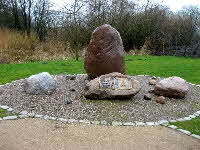|
 Im Jahre 1633, 3 Jahre, nachdem in Papenburg, Emsland, die erste Deutsche Fehnsiedlung gegründet wurde, haben Kaufleute aus Emden nördlich von Timmel Moorland in Erbpacht von Graf Ulrich erworben, um hier eine Fehnkolonie zu errichten. Vom Ufer des Flusses Flumm wurde ein Kanal ins Hochmoor getrieben, über den das Hochmoor entwässert werden sollte, um danach den Torf zu stechen und als Brennstoff, vor allem für die Städte Emden, Leer und Weener, zu gewinnen. Deren Versorgung mit Brenntorf aus den Niederlanden war durch die Wirren des 30-jährigen Krieges unterbrochen. So wurde die zweite Fehngründung überhaupt die erste Ostfriesische Fehnkolonie. Im Jahre 1633, 3 Jahre, nachdem in Papenburg, Emsland, die erste Deutsche Fehnsiedlung gegründet wurde, haben Kaufleute aus Emden nördlich von Timmel Moorland in Erbpacht von Graf Ulrich erworben, um hier eine Fehnkolonie zu errichten. Vom Ufer des Flusses Flumm wurde ein Kanal ins Hochmoor getrieben, über den das Hochmoor entwässert werden sollte, um danach den Torf zu stechen und als Brennstoff, vor allem für die Städte Emden, Leer und Weener, zu gewinnen. Deren Versorgung mit Brenntorf aus den Niederlanden war durch die Wirren des 30-jährigen Krieges unterbrochen. So wurde die zweite Fehngründung überhaupt die erste Ostfriesische Fehnkolonie.
Im Jahre 2008 wurde das 375-jährige Jubiläum von Großefehn aufwendig gefeiert.
Am Ufer der Flumm, wo das Fehnprojekt dereinst begonnen wurde, erinnert heute ein Monumentenensemble aus einigen Granitsteinen, wie sie typischer Weise im Sand der dem Moor untergelagerten Grundmoränen der Eiszeiten zu finden sind, an dieses geschichtsträchtige Ereignis. Eine eingemeißelte Inschrift besagt
Beginn der Ostfriesischen Fehnkultur Anno 1633
In 1633, 3 years after the first founding of a fen colony at Papenburg, Emsland, the first fen colony of Ostfriesland was founded by 4 merchants of Emden who purchased moorlands north of the village of Timmel from count Ulrich of Ostfriesland in leasehold in order to install a fen colony.
A canal was excavated from the banks of the river Flumm to the high moorland and then into the moors in order to drain the moors and later cut the peat as fuel for the households of the
cities of Emden, Leer and Weener. Their supply of fuel from the Netherlands was interrupted because of the turmoil of the 30-years war.
Thus the second founding of a fen colony became the first fen colony in Ostfriesland, Timmeler Fehn, later Timmeler Großefehn, still later and today Großefehn.
In 2008 the 375th anniversary of Großefehn was lavishly celebrated.
A memorial ensemble of granite stones on the banks of the river Flumm, as they were ususaly found in the sandy soils below the moorlands as a reminder of the glaciers that primarily covered this region during Ice Age remembers this historical event.
A script is engraved into the basic stone: Begin of the East Frisian Fen Culture AD 1633
|